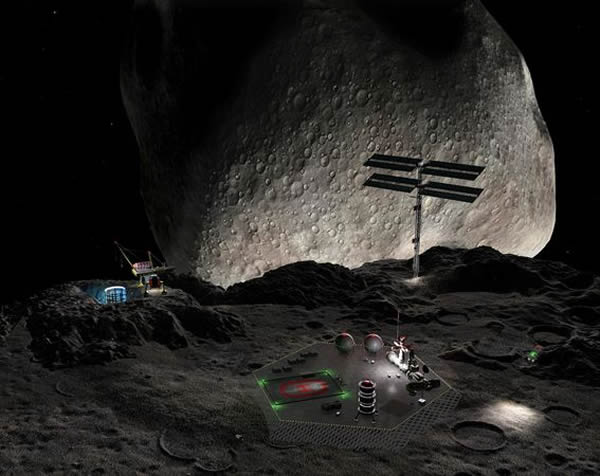NASA Announces Plan for Capturing Asteroid
NASA wants to identify an interesting asteroid flying around deep space, figure out a way to capture the spinning and hard-to-grab orb, nudge it into our planetary region and then set it into orbit around the moon, the agency announced Wednesday.
The capture would be performed robotically, and the re-located asteroid would become a destination for astronauts to explore—and, possibly, for space entrepreneurs to mine.
The idea may sound more like science fiction than national policy, but it actually fits in with key goals of the Obama administration and space community.
Those goals include learning how to identify asteroids heading towards us and to change their course, finding destinations where astronauts can go as they try to learn how to make the longer trip to Mars, and to prove opportunities for space investors.
Computer artwork of a hypothetical asteroid mining settlement.
"This mission represents an unprecedented technological feat that will lead to new scientific discoveries and technological capabilities and help protect our home planet," NASA Administrator Charles Bolden said in a statement before the plan was announced on Wednesday.
"This asteroid initiative brings together the best of NASA's science, technology and human exploration efforts to achieve the president's goal of sending humans to an asteroid by 2025," his statement continued.
Planning for the effort has just begun, and Bolden said teams will be meeting over the summer to work out how to select the right asteroid, how to get a spacecraft to it, and how to tow it many millions of miles to our moon.
The NASA idea is similar to one developed by scientists at the Keck Institute for Space Studies at the California Institute of Technology, and proposed by them last year.
A robotic spacecraft could drag a 23-foot, 500-ton near-Earth asteroid (NEA) using currently available technology, the Keck scientists concluded, though that technology would have to be modified somewhat. That team concluded that the project would cost $2.6 billion, but NASA officials say its effort would cost much less.
The asteroid proposal was part of the NASA budget rollout for 2014, part of the broader federal budget that President Barack Obama unveiled Wednesday, April 10, 2013, and it included an initial $104 million for the project.
But Bolden said the plan could go forward only if the federal government could rollback the cuts made as a result of the sequester.
As explained by Paul Dimotakis, one of the Keck scientists who worked on the project, the physics of the endeavor requires NASA to target a relatively small asteroid of 500 to 1,000 tons. It needs to be the consistency of dried mud and to be on a trajectory that would take it close to the Earth and moon even without a tug.
It would not be an asteroid in the main belt between Mars and Jupiter, but would be one in Earth's extended neighborhood to start.
Dimotakis listed numerous reasons for undertaking the project, but emphasized two in particular.
Because asteroids are among the oldest objects in the solar system, he said, bringing one to a place where it could be studied intensely would allow scientists to much better understand what that early solar system was like.
And if the long-term goal of American space exploration is to send astronauts to Mars—which President Obama has proposed for the 2030s—then space program managers need achievable milestones to prepare for that mission.
Marc Kaufman
for National Geographic News
Published April 10, 2013












